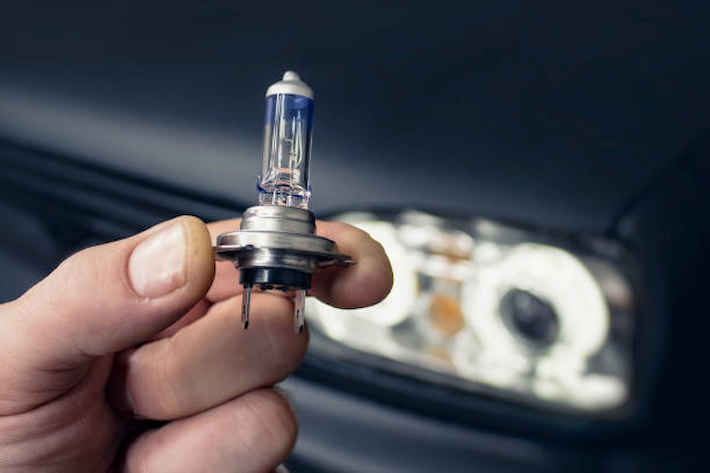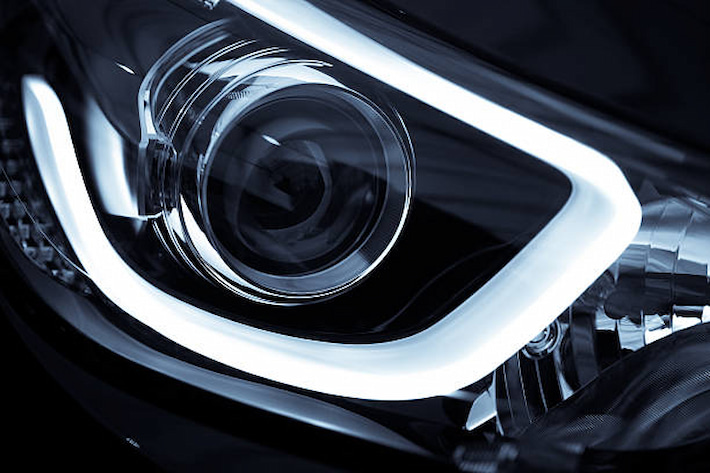Car headlights have changed a lot since the days of oil lamps on early automobiles. Electric headlights arrived in the early 1900s, making night driving safer and more common. Over the years, new technologies like halogen and Xenon have made automotive headlights brighter and longer-lasting. Today, LED technology, first made popular with flashlights, is found in most new vehicles, and it’s mainly because of their efficiency, reliability and longevity.
Types of Headlights

Halogen
Halogen headlights are the most common type found on older vehicles and on more affordable ones, too. They work by sending electricity through a tungsten filament inside a bulb filled with halogen gas, which creates a warm, yellowish light. A halogen car headlight is affordable and easy to replace, which is why it’s such a popular design. However, halogen lights aren’t as energy efficient as their more advanced counterparts and have a shorter lifespan. They also generate more heat, which means some energy is being wasted.
LED
LED headlights have quickly become the standard in modern automotive headlights as they rely on semiconductors to produce a bright, white light that is both powerful and energy-efficient. They last much longer than halogen bulbs, often up to 50,000 hours, and use less power in the process. LEDs also allow for more creative headlight shapes, and their instant-on feature is great for both headlights and signal lights. However, LEDs are more expensive to replace than halogen lights.
Xenon
Xenon headlights, also known as HID (High-Intensity Discharge) headlights, use Xenon gas to create a bright, bluish-white light. Unlike halogen bulbs, Xenon car headlight options don’t use a filament, instead, they are able to generate an arc between two electrodes. This makes for a very intense beam of light and makes Xenon bulbs last longer than halogen bulbs, however, they don’t have the lifespan of LEDs. Xenon lights are often found in luxury vehicles and can be more expensive as they need special equipment to be installed.
Laser
Laser headlights are the newest advancement in car headlight design. They rely on laser diodes to create an extremely bright and focused beam of light, which makes them more efficient than LEDs. Laser headlights can also light up the road much farther ahead, which is great for high-speed driving and in poor visibility areas. However, laser headlights are mostly found in high-end luxury vehicles since laser systems are complex and thus quite expensive to replace.
Types of Headlight Bulbs
Sealed Beam
Sealed beam headlights combine the bulb, reflector and lens into one sealed unit. Which means when the bulb burns out, the whole assembly has to be replaced. These units are quite tough, though and were once standard for most vehicles, but they don’t offer as much design flexibility or light output as newer solutions.
Composite
Composite headlights separate the bulb from the housing, so you only have to replace the bulb, not the whole unit, when the time comes. This makes these replacement headlights more affordable and more convenient. Composite designs also allow for more aerodynamic and stylish headlight shapes.
Reflector
Reflector headlights use a reflective housing to direct the light from the bulb onto the road. They’re quite simple, cost-effective and have been used in headlights for many decades. Reflector designs work well with most types of bulbs, however, they can sometimes cause uneven light patterns and increase the amount of glare they produce for other drivers.
Projector
A projector headlight uses a lens to focus and direct the beam, which helps create a sharper and more controlled pattern, which also helps reduce glare and improve visibility. Projector headlights are often paired with Xenon or LED bulbs and are common in many of today’s vehicles as they make for a more modern appearance and offer better performance than reflector headlights.
What Matters in a Headlight?

Lumens
The number of lumens produced by a headlight tells how bright it can be. More lumens mean a brighter light, which can help you see better at night. But too bright of a light can produce glare, so it’s important to find a balance here.
Longevity
How long a headlight bulb lasts is important, especially for replacement headlights. Halogen bulbs usually last anywhere between 1,000 and 2,000 hours, Xenon bulbs last from 3,000 to 8,000 hours, and LED bulbs can last up to 50,000 hours. Longer-lasting bulbs mean less hassle and fewer expenses in the long run.
Compatibility
Not every headlight fits every car. Always check your vehicle’s manual or ask a professional to make sure the replacement headlights you choose are compatible with your make and model. Using the wrong type can have a negative effect on both performance and safety.
Power
Different types of headlights use different amounts of power. LEDs are the most energy-efficient, using up to 80% less power than halogen bulbs. Lower power consumption is better for your car’s battery and overall efficiency, especially when it comes to electric vehicles.
Auto Leveling
An auto levelling feature is found in most modern headlights, especially on projector or adaptive systems. It helps keep the headlights aimed at the right angle, even when the car is loaded or when driving on an uneven road surface. This helps ensure the beam is always in the right place, in order to improve safety and reduce glare.



